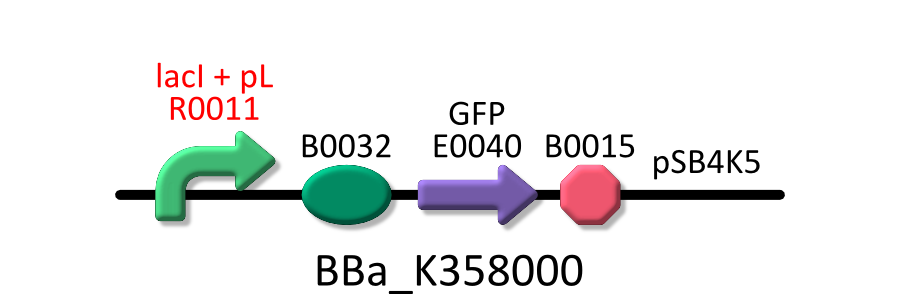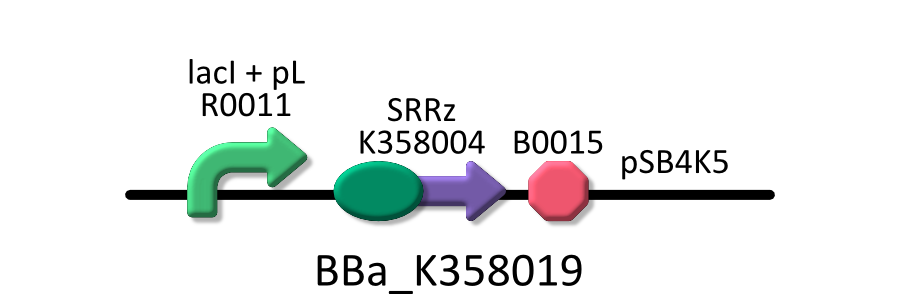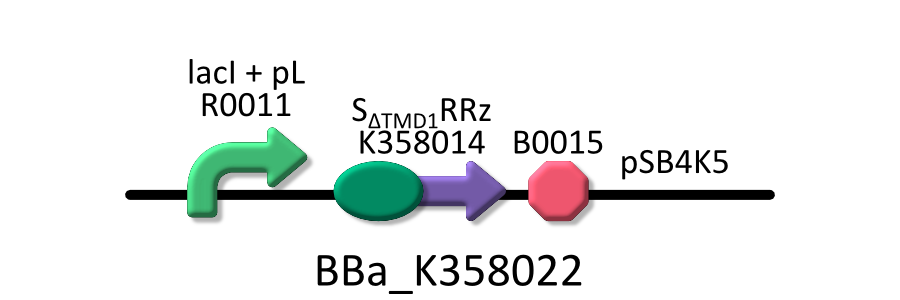Team:Kyoto/Project
From 2010.igem.org
(→Goal A: Characterization of R0011, a strong lactose promoter) |
(→Goal A: Characterization of R0011, a strong lactose promoter) |
||
| Line 22: | Line 22: | ||
====[[Team:Kyoto/Project/Goal A|Goal A]]: Characterization of R0011, a strong lactose promoter==== | ====[[Team:Kyoto/Project/Goal A|Goal A]]: Characterization of R0011, a strong lactose promoter==== | ||
| - | [[Image:KyotoFigA001.png|300px| | + | [[Image:KyotoFigA001.png|300px|center]] |
We used R0011, which is one of the most commonly used parts in iGEM, to characterize our genes because the strength of promoter activity is very high. However, in previous iGEM, no teams didn't characterize R0011 with RPU. We tried to determine what is the ratio of activity of R0011, a lactose promoter when cell lysis occurs. Therefore, in oreder to characterize killer and anti-killer, we have to characterize R0011. | We used R0011, which is one of the most commonly used parts in iGEM, to characterize our genes because the strength of promoter activity is very high. However, in previous iGEM, no teams didn't characterize R0011 with RPU. We tried to determine what is the ratio of activity of R0011, a lactose promoter when cell lysis occurs. Therefore, in oreder to characterize killer and anti-killer, we have to characterize R0011. | ||
Revision as of 18:38, 25 October 2010
Contents |
Project
Introduction
Background
The cell-death device is required in many fields. In bioremediation, for example, this device can prevent introduced bacteria from disrupting the ecosystem. Also, It can be applied to other ideas such as E.coli capsules which scatter drug or aroma by cell-lysis responding to a certain signal. Therefore, the cell death devices based on diverse approaches, including previous iGEM projects have been developed. However, present cell-death devices are still not easy to use, because of the poor characterization or strict restriction on promoters' activity and so on. Therefore, we attempt to register on BioBrick better characterized and more useful cell-death device to contribute to every future team.
Problems of Present Cell-Death Devices
In order to design a universal and applicable cell-death device, we need to reduce the restriction on promoter's activity and to characterize the strength of the cell-death function.
1. Solution to the Restriction on Promoter's Activity
In constructing a simple circuit consisting of an inducible promoter and a killer-gene, the combinations are limited by the promoter's leak, strength of killer-function and many other factors. We looked for the solution to this problem and came up with an idea of using an Tanti-killer gene as well with two promoters (a constitutive one and an inducible one). With this circuit, we can apply more promoters to this device by using an appropriate constitutive promoter.
We considered that Lysis cassette of λ phage and its antagonist, SΔTMD1 are the most appropriate to Killer-gene and Anti-killer gene. This was because some iGEM teams in the past already dealt with lysis cassette and also because we found some articles that shows the effect of SΔTMD1 in the yeast. For more detailed explanation of LysisCassete, go LearnMore
2. Need for Characterization
In fact, there is no experimental data about the present devices in the iGEM's cell-death category. Quantitative analysis of Lysis cassette is necessary. To contribute to iGEM in this category with well characterized device, we did experimentations and some modeling.
Overview
Goal A: Characterization of R0011, a strong lactose promoter
We used R0011, which is one of the most commonly used parts in iGEM, to characterize our genes because the strength of promoter activity is very high. However, in previous iGEM, no teams didn't characterize R0011 with RPU. We tried to determine what is the ratio of activity of R0011, a lactose promoter when cell lysis occurs. Therefore, in oreder to characterize killer and anti-killer, we have to characterize R0011.
Goal B: Characterization of λ Lysis cassette
To characterize λlysiscassette, we made below construct and observed E.coli transformed with the constructs in various concentration of IPTG.
Goal C: Characterization of the anti-killer gene, SΔTMD1
E.coli transformed with the constructs below was grown in medium without IPTG and IPTG was added to the culture at proper time. The A550 of the culture was measured and the result was compared with that of the experiment of the killer gene in order to find whether the anti-killer gene works correctly.
Protocols
See below pages for details.
Notebook
- Notebook1: Construction for Lysisbox.
- Notebook2: Measurement of R0011.
- Team:Kyoto/LearnMore
References
- [http://www.ncbi.nlm.nih.gov/pubmed/20395970 PMID: 20395970] Khalil AS, Collins JJ., Synthetic biology: applications come of age., Nat Rev Genet. 2010 May;11(5):367-79.
- [http://www.ncbi.nlm.nih.gov/pubmed/15832375 PMID: 15832375] Paul D, Pandey G, Jain RK., Suicidal genetically engineered microorganisms for bioremediation: need and perspectives., Bioessays. 2005 May;27(5):563-73.
- [http://www.ncbi.nlm.nih.gov/pubmed/15973534 PMID: 15973534] Davison J., Risk mitigation of genetically modified bacteria and plants designed for bioremediation., J Ind Microbiol Biotechnol. 2005 Dec;32(11-12):639-50. Epub 2005 Jun 23.
- [http://www.ncbi.nlm.nih.gov/pubmed/19897658 PMID: 19897658] White R, Tran TA, Dankenbring CA, Deaton J, Young R., The N-terminal transmembrane domain of lambda S is required for holin but not antiholin function., J Bacteriol. 2010 Feb;192(3):725-33. Epub 2009 Nov 6.
- [http://www.ncbi.nlm.nih.gov/pubmed/7768829 PMID: 7768829] Chang CY, Nam K, Young R., S gene expression and the timing of lysis by bacteriophage lambda., J Bacteriol. 1995 Jun;177(11):3283-94.
- [http://www.ncbi.nlm.nih.gov/pubmed/18713319 PMID: 18713319] Berry J, Summer EJ, Struck DK, Young R., The final step in the phage infection cycle: the Rz and Rz1 lysis proteins link the inner and outer membranes., Mol Microbiol. 2008 Oct;70(2):341-51. Epub 2008 Aug 18.
- [http://www.ncbi.nlm.nih.gov/pubmed/11459934 PMID: 11459934] Gründling A, Manson MD, Young R., Holins kill without warning., Proc Natl Acad Sci U S A. 2001 Jul 31;98(16):9348-52. Epub 2001 Jul 17.
- [http://www.ncbi.nlm.nih.gov/pubmed/9573208 PMID: 9573208] Smith DL, Struck DK, Scholtz JM, Young R., Purification and biochemical characterization of the lambda holin., J Bacteriol. 1998 May;180(9):2531-40.
- [http://www.ncbi.nlm.nih.gov/pubmed/19298678 PMID: 19298678] Kelly JR, Rubin AJ, Davis JH, Ajo-Franklin CM, Cumbers J, Czar MJ, de Mora K, Glieberman AL, Monie DD, Endy D., Measuring the activity of BioBrick promoters using an in vivo reference standard., J Biol Eng. 2009 Mar 20;3:4.
- [http://www.ncbi.nlm.nih.gov/pubmed/2147680 PMID: 2147680] Garrett J, Bruno C, Young R., Lysis protein S of phage lambda functions in Saccharomyces cerevisiae., J Bacteriol. 1990 Dec;172(12):7275-7.
 "
"




